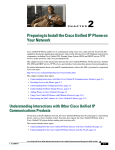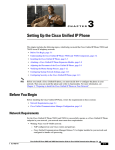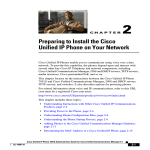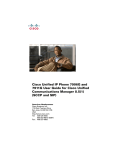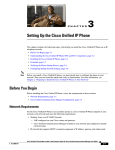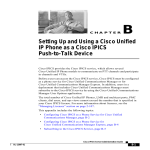Download Cisco Systems OL-18988-01 User's Manual
Transcript
CH A P T E R 3 Setting Up the Cisco Unified IP Phone This chapter includes the following topics, which help you install the Cisco Unified IP Phone 7931G on an IP telephony network: Note • Before You Begin, page 3-1 • Understanding the Cisco Unified IP Phone 7931G Components, page 3-2 • Installing the Cisco Unified IP Phone, page 3-5 • Securing the Phone with a Cable Lock, page 3-6 • Mounting the Phone to the Wall, page 3-7 • Verifying the Phone Startup Process, page 3-8 • Configuring Startup Network Settings, page 3-9 • Configuring Security on the Cisco Unified IP Phone, page 3-9 Before you install a Cisco Unified IP Phone, you must decide how to configure the phone in your network. Then you can install the phone and verify its functionality. For more information, see Chapter 2, “Preparing to Install the Cisco Unified IP Phone on Your Network.” Before You Begin Before installing the Cisco Unified IP Phone, review the requirements in these sections: • Network Requirements, page 3-1 • Cisco Unified Communications Manager Configuration, page 3-2 Network Requirements For the Cisco Unified IP Phone 7931G to successfully operate as a Cisco Unified IP Phone endpoint in your network, your network must meet these requirements: • Working Voice over IP (VoIP) network: – VoIP configured on your Cisco routers and gateways – Cisco Unified Communications Manager Release 4.x or higher installed in your network and configured to handle call processing Cisco Unified IP Phone 7931G Administration Guide for Cisco Unified Communications Manager 7.1 (SCCP and SIP) OL-18988-01 3-1 Chapter 3 Setting Up the Cisco Unified IP Phone Understanding the Cisco Unified IP Phone 7931G Components • Note IP network that supports DHCP or manual assignment of IP address, gateway, and subnet mask The Cisco Unified IP Phone displays the date and time from Cisco Unified Communications Manager. If the Cisco Unified Communications Manager server is located in a different time zone than the phones, the phones will not display the local time. Cisco Unified Communications Manager Configuration The Cisco Unified IP Phone requires Cisco Unified Communications Manager to handle call processing. Refer to Cisco Unified Communications Manager Administration Guide or to context-sensitive help in the Cisco Unified Communications Manager application to ensure that Cisco Unified Communications Manager is set up properly to manage the phone and to properly route and process calls. If you plan to use auto-registration, verify that it is enabled and properly configured in Cisco Unified Communications Manager Administration before connecting any Cisco Unified IP Phone to the network. For information about enabling and configuring auto-registration, refer to Cisco Unified Communications Manager Administration Guide. Also, see the “Adding Phones to the Cisco Unified Communications Manager Database” section on page 2-7. You must use Cisco Unified Communications Manager Administration to configure and assign telephony features to the Cisco Unified IP Phones. See the “Telephony Features Available for the Phone” section on page 5-1 for details. In Cisco Unified Communications Manager Administration, you can add users to the database and associate them with specific phones. In this way, users gain access to Cisco Unified CM User Option Pages that allow them to configure items such as call forwarding, speed dialing, and voice messaging system options. See the “Adding Users to Cisco Unified Communications Manager” section on page 5-18 for details. Understanding the Cisco Unified IP Phone 7931G Components The Cisco Unified IP Phone 7931G includes these components on the phone or as accessories for the phone: • Network and Access Ports, page 3-2 • Handset, page 3-3 • Speakerphone, page 3-3 • Headset, page 3-3 Network and Access Ports The back of the Cisco Unified IP Phone includes these ports: • Network port—Labeled 10/100 SW • Access port—Labeled 10/100 PC Each port supports 10/100 Mbps half- or full-duplex connections to external devices. You can use either Category 3 or 5 cabling for 10-Mbps connections, but you must use Category 5 for 100 connections. Cisco Unified IP Phone 7931G Administration Guide for Cisco Unified Communications Manager 7.1 (SCCP and SIP) 3-2 OL-18988-01 Chapter 3 Setting Up the Cisco Unified IP Phone Understanding the Cisco Unified IP Phone 7931G Components Use the SW network port to connect the phone to the network. You must use a straight-through cable on this port. The phone can also obtain inline power from a switch over this connection. See the “Providing Power to the Phone” section on page 2-3 for details. Use the PC access port to connect a network device, such as a computer, to the phone. You must use a straight-through cable on this port. Handset The handset is designed especially for use with the Cisco Unified IP Phone 7931G. It includes a light strip that indicates incoming calls and voice messages waiting. To connect a handset to the Cisco Unified IP Phone, plug the cable into the handset and the Handset port on the back of the phone. Note The handset does not support wideband audio. Speakerphone By default, the speakerphone is enabled on the Cisco Unified IP Phone 7931G. You can disable the speakerphone by using the Cisco Unified Communications Manager Administration. To do so, choose Device > Phone and locate the phone you want to modify. In the Phone Configuration window for the phone, check the Disable Speakerphone check box. Headset Although Cisco performs internal testing of third-party headsets for use with the Cisco Unified IP Phones, Cisco does not certify or support products from headset or handset vendors. Cisco recommends the use of good quality external devices, for example, headsets that are screened against unwanted radio frequency (RF) and audio frequency (AF) signals. Depending on the quality of headsets and their proximity to other devices such as mobile phones and two-way radios, some audio noise or echo may still occur. An audible hum or buzz may be heard by either the remote party or by both the remote party and the Cisco Unified IP Phone user. Humming or buzzing sounds can be caused by a range of outside sources; for example, electric lights, electric motors, or PC monitors. See Using External Devices, page 3-4 for more information. Note The Cisco Unified IP Phone 7931G supports wideband headsets. Note In some cases, hum may be reduced or eliminated by using a local power cube or power injector. These environmental and hardware inconsistencies in the locations where Cisco Unified IP Phones are deployed means that there is not a single headset solution that is optimal for all environments. Cisco recommends that customers test headsets in their intended environment to determine performance before making a purchasing decision and deploying en mass. Cisco Unified IP Phone 7931G Administration Guide for Cisco Unified Communications Manager 7.1 (SCCP and SIP) OL-18988-01 3-3 Chapter 3 Setting Up the Cisco Unified IP Phone Understanding the Cisco Unified IP Phone 7931G Components Audio Quality Subjective to the User Beyond the physical, mechanical and technical performance, the audio portion of a headset must sound good to the user and to the party on the far end. Sound quality is subjective and Cisco cannot guarantee the performance of any headsets. However, a variety of headsets from leading headset manufacturers have been reported to perform well with Cisco Unified IP Phones. See manufacturer’s sites for details. Connecting a Headset To connect a headset to the Cisco Unified IP Phone, plug it into the Headset port on the back of the phone. Press the Headset button on the phone to place and answer calls using the headset. You can use the headset with all of the features on the Cisco Unified IP Phone, including the Volume and Mute buttons. Use these buttons to adjust the ear piece volume and to mute the speech path from the headset microphone. Disabling a Headset You can disable the headset by using the Cisco Unified Communications Manager Administration. If you do so, you also will disable the speakerphone. To disable the headset from Cisco Unified Communications Manager Administration, choose Device > Phone and locate the phone that you want to modify. In the Phone Configuration window for the phone, check the Disable Speakerphone and Headset check box. Using External Devices The following information applies when you use external devices with the Cisco Unified IP Phone: Cisco recommends the use of good quality external devices that are shielded (screened) against unwanted radio frequency (RF) and audio frequency (AF) signals. Depending on the quality of these devices and their proximity to other devices such as mobile phones or two-way radios, some audio noise may still occur. In these cases, Cisco recommends that you take one or more of the following actions: • Move the external device away from the source of the RF or AF signals. • Route the external device cables away from the source of the RF or AF signals. • Use shielded cables for the external device, or use cables with a better shield and connector. • Shorten the length of the external device cable. • Apply ferrites or other such devices on the cables for the external device. Cisco cannot guarantee the performance of the system because Cisco has no control over the quality of external devices, cables, and connectors. The system will perform adequately when suitable devices are attached using good quality cables and connectors. Caution In European Union countries, use only external headsets that are fully compliant with the EMC Directive [89/336/EC]. Cisco Unified IP Phone 7931G Administration Guide for Cisco Unified Communications Manager 7.1 (SCCP and SIP) 3-4 OL-18988-01 Chapter 3 Setting Up the Cisco Unified IP Phone Installing the Cisco Unified IP Phone Installing the Cisco Unified IP Phone You must connect the Cisco Unified IP Phone to the network and to a power source before using it. See Figure 3-1 for a graphical representation of the connections. Perform the steps shown in Table 3-1 to install a Cisco Unified IP Phone. Table 3-1 Installing the Cisco Unified IP Phone Installation Step Notes Reference Step 1 Connect the handset to — the Handset port. Step 2 Connect a headset to the Headset port. Step 3 Connect the power Optional. supply to the Cisco DC Adapter port. Step 4 Connect a Category 3 or 5 straight-through Ethernet cable from the switch to the 10/100 SW port. Each Cisco Unified IP Phone ships with one Ethernet cable in the box. See the “Network and Access Ports” section on page 3-2 for guidelines. Step 5 Connect a Category 3 or 5 straight-through Ethernet cable from another network device, such as a desktop computer, to the 10/100 PC port. Optional. You can connect another network device later if you do not connect one now. See the “Network and Access Ports” section on page 3-2 for guidelines. — Optional. You can add a headset later if See the “Headset” section you do not connect one now. on page 3-3 for supported headsets. See the “Providing Power to the Phone” section on page 2-3. Cisco Unified IP Phone 7931G Administration Guide for Cisco Unified Communications Manager 7.1 (SCCP and SIP) OL-18988-01 3-5 Chapter 3 Setting Up the Cisco Unified IP Phone Securing the Phone with a Cable Lock Figure 3-1 Cisco Unified IP Phone 7931G Cable Connections 10/100 SW 10/100 PC DC48V 1 5 4 3 170686 2 1 DC adaptor (dc48v) (Optional) 2 10/100 SW connection 3 10/100 PC port connection 4 Headset connection 5 Handset connection Related Topics • Before You Begin, page 3-1 • Securing the Phone with a Cable Lock, page 3-6 • Configuring Startup Network Settings, page 3-9 Securing the Phone with a Cable Lock You can secure the Cisco Unified IP Phone 7931G to a desktop using a laptop cable lock. The lock connects to the security slot on the back of the phone, and the cable can be secured to a desktop. The security slot can accommodate a lock up to 20 mm. Compatible laptop cable locks include the Kensington laptop cable lock and laptop cable locks from other manufacturers that can fit into the security slot on the back of the phone. See Figure 3-2. Cisco Unified IP Phone 7931G Administration Guide for Cisco Unified Communications Manager 7.1 (SCCP and SIP) 3-6 OL-18988-01 Chapter 3 Setting Up the Cisco Unified IP Phone Mounting the Phone to the Wall Connecting a Cable Lock to the Cisco Unified IP Phone 7931G 182098 Figure 3-2 Mounting the Phone to the Wall You can mount the Cisco Unified IP Phone on the wall using special brackets that are available in a Cisco Unified IP Phone wall mount kit. (Wall mount kits must be ordered separately from the phones.) You can also attach the phone to the will without a wall mount kit. In either case, you need the following tools and parts: • Screwdriver • Screws to secure the Cisco Unified IP Phone to the wall (included with the wall mount kit Before You Begin To ensure that the handset attaches securely to a wall-mounted phone, remove the handset wall hook from the handset rest, rotate the hook 180 degrees, and reinsert the hook. Turning the hook exposes a lip on which the handset catches when the phone is vertical. For an illustrated procedure, refer to Installing the Universal Wall Mount Kit for the Cisco Unified IP Phone at http://www.cisco.com/en/US/products/hw/phones/ps379/prod_installation_guides_list.html Cisco Unified IP Phone 7931G Administration Guide for Cisco Unified Communications Manager 7.1 (SCCP and SIP) OL-18988-01 3-7 Chapter 3 Setting Up the Cisco Unified IP Phone Verifying the Phone Startup Process To mount the phone on the wall without using the wall mount kit, follow these steps: Caution Use care not to damage wires or pipes located inside the wall when securing screws to wall studs. Procedure Step 1 Remove the footstand if it is attached to the phone. To remove the footstand, disengage its tabs from the phone by grasping and gently squeeze it at the top and bottom near where it attaches to the phone. Step 2 Insert two screws into a wall stud, matching them to the two screw holes on the back of the phone. The holes fit standard phone jack mounts. Step 3 Hang the phone on the wall. Verifying the Phone Startup Process After the Cisco Unified IP Phone has power connected to it, the phone begins its startup process by cycling through these steps. 1. These buttons flash on and off in sequence: – Mute. – Speaker. – Line 1 (amber) 2. The phone screen displays the Cisco Systems, Inc., logo screen. 3. These messages display as the phone starts: – Verifying load (if the phone load does not match the load on the TFTP server). If this message displays, the phone start up again and repeats step 1 and 2 above. The phone also displays the download progress and names of files it downloads and upgrades. – Configuring IP. – Updating CTL. – Updating Locale. – Configuring CM Unified List. – Registering. 4. The main phone screen displays: – Current date and time – Primary directory number – Additional directory numbers and speed dial numbers, if configured – Softkeys If the phone successfully passes through these stages, it has started up properly. If the phone does not start up properly, see the “Resolving Startup Problems” section on page 9-1. Cisco Unified IP Phone 7931G Administration Guide for Cisco Unified Communications Manager 7.1 (SCCP and SIP) 3-8 OL-18988-01 Chapter 3 Setting Up the Cisco Unified IP Phone Configuring Startup Network Settings Configuring Startup Network Settings If you are not using DHCP in your network, you must configure these network settings on the Cisco Unified IP Phone after installing the phone on the network: • IP address • IP subnet information (subnet mask for IPv4 and subnet prefix length for IPv6) • Default gateway IP address • TFTP server IP address You also may configure the domain name and the DNS server settings, if necessary. Collect this information and see the instructions in Chapter 4, “Configuring Settings on the Cisco Unified IP Phone.” Configuring Security on the Cisco Unified IP Phone The security features protect against several threats, including threats to the identity of the phone and to data. These features establish and maintain authenticated communication streams between the phone and the Cisco Unified Communications Manager server, and digitally sign files before they are delivered. For more information about the security features, see the “Understanding Security Features for Cisco Unified IP Phones” section on page 1-11. Also, refer to Cisco Unified Communications Manager Security Guide. A Locally Significant Certificate (LSC) installs on phones after you perform the necessary tasks that are associated with the Certificate Authority Proxy Function (CAPF). You can use Cisco Unified Communications Manager Administration to configure an LSC, as described in Cisco Unified Communications Manager Security Guide. Alternatively, you can initiate the installation of an LSC from the Security Configuration menu on the phone. This menu also lets you update or remove an LSC. Before you do so, make sure that the appropriate Cisco Unified Communications Manager and the Certificate Authority Proxy Function (CAPF) security configurations are complete: • The CTL file should have a CAPF certificate. • The CAPF certificate must exist in the /usr/local/cm/.security/certs folder in every server in the cluster. • The CAPF is running and configured. Refer to Cisco Unified Communications Manager Security Guide for more information. Depending on how you have configured the CAPF, this procedure installs an LSC, updates an existing LSC, or removes an existing LSC. To configure an LSC on the phone, follow these steps: Procedure Step 1 Obtain the CAPF authentication code that was set when the CAPF was configured. Step 2 From the phone, press the Applications Menu button, then choose Settings > Security Configuration. Cisco Unified IP Phone 7931G Administration Guide for Cisco Unified Communications Manager 7.1 (SCCP and SIP) OL-18988-01 3-9 Chapter 3 Setting Up the Cisco Unified IP Phone Configuring Security on the Cisco Unified IP Phone Note Step 3 Press **# to unlock settings on the Security Configuration menu. Note Step 4 You can control access to the Settings Menu by using the Settings Access field in the Cisco Unified Communications Manager Administration Phone Configuration Settings window. For more information, see Cisco Unified Communications Manager Administration Guide. If a Settings Menu password has been provisioned, SIP phones present an “Enter password” prompt after you enter **#. Scroll to LSC and press the Update softkey. The phone prompts for an authentication string. Step 5 Enter the authentication code and press the Submit softkey. The phone begins to install, update, or remove the LSC, depending on how the CAPF was configured. During the procedure, a series of messages appears in the LSC option field in the Security Configuration menu so that you can monitor progress. When the procedure completes successfully, the phone will display Installed or Not Installed. The LSC install, update, or removal process can take a long time to complete. You can stop the process at any time by pressing the Stop softkey from the Security Configuration menu. (Settings must be unlocked before you can press this softkey.) When the phone successfully completes the installation procedure, it displays “Success.” If the phone displays, “Failure,” the authorization string may be incorrect or the phone may not enabled for upgrading. Refer to error messages generated by the CAPF and take appropriate actions. You can verify that an LSC is installed on the phone by pressing the Applications Menu button, choosing Settings > Model Information, and ensuring that the LSC setting shows Installed. Related Topic • Understanding Security Features for Cisco Unified IP Phones, page 1-11 Cisco Unified IP Phone 7931G Administration Guide for Cisco Unified Communications Manager 7.1 (SCCP and SIP) 3-10 OL-18988-01










